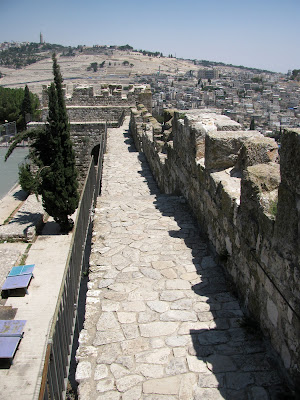Last Christmas the hubby and I visited the village of Ein Kerem, now a neighbourhood of southwest Jerusalem. Truthfully we weren't really thinking about it being Christmas time - it was a regular December weekend for us - so it was a pleasant surprise to see all the festive trees dotted around the neighbourhood.
Ein Kerem, which means "Spring of the Vineyard", has been an Israeli village since 1948 and in recent years has become home to a population of artists and craftsmen. According to Christian tradition
John the Baptist was born there. There are two churches by this name in the village.
Though the buildings hold no particular religious importance to us, we were happy to stroll around the village to see the sites and quaint little alleys. The
Church of the Visitation on top of a hill honours the visit paid by Mary, Jesus' mother, to Elizabeth, John the Baptist's mother. The views from the church square of the Jerusalem Hills were stunning and the modern church, built in 1955 on top of ancient church remnants, is impressive. The lower church houses the rock that hid Elizabeth and John from
King Herod, who had sent his soldiers to slaughter all the sons of the Tribe of Judea. An inscription in Italian reads
pietra del nascondiment, "the stone in which John was concealed".


The Catholic church of St. John the Baptist, below, was built in the second half of the 19th century on the remnants of earlier Byzantine and Crusader churches. Inside are the remains of an ancient mosaic floor and a cave where, according to Christian tradition, John the Baptist was born. Remnants have also been found below the building of a
mikve, a bath used for the purpose of ritual immersion in Judaism, dating to the
Second Temple period (between 530 BCE and 70 CE). On the church's walls there are paintings that depict the fourteen Stations of the Cross, the Via Dolorosa, a typical theme in all Catholic churches. Then church has been in the hands of the
Franciscans since 1674.



Close to the main street of Ein Kerem, where many restaurants are located, we stopped at a fresh-water spring which, according to tradition, is the location where Mary and Elizabeth met and where Mary drank from its water. The spring waters are considered holy by some Catholic and Orthodox pilgrims, though sadly today the water is contaminated by runoff sewage and drinking it is not recommended. Former Arab inhabitants of the village also built a mosque on the site.

There are other notable buildings in Ein Kerem.
The Ein Kerem Music Centre was once the home of the local sheik, the village head.
The Convent of the Sisters of Our lady of Zion, hidden behind a stone wall, is one of the most beautiful buildings in the village. Built around 150 years ago, the building was once an orphanage for Christian girls from Lebanon and is now home to a community of Catholic nuns. Above the village
The Yelizavetta Fyodorovna Church was built by the Russian Orthodox Church at the end of the 19th century but only completed 100 years later, in 2005. This church is decorated by a tented roof, similar to other Russian churches, and was nicknamed "Moskovia" (Arabic for Moscow) by local villagers. In 1961 the
Hadassah Ein Kerem hospital, where my sons were born, was built to replace the medical facility on Mount Scopus which had become unreachable when Jerusalem was divided in two after the
War of Independence. Today Jerusalem is reunited and is the site of
two Hadassah hospitals.
Besides the churches and old stone buildings Ein Kerem is also home to an abundance of galleries and restaurants. The kids were not with us on the day we visited so we decided to end our walk with a good lunch! Eager to enjoy the wonderful views of the valley below us we chose to sit outdoors on one of the restaurant's rooftops. It was chilly - no, cold - but hot drinks and blankets soon warmed us up and we found it a wonderful way to enjoy the picturesque lanes of Ein Kerem, a neighbourhood so close to the city of Jerusalem and yet with such a different atmosphere.
Whilst the Jewish people worldwide have already celebrated Hanukkah (this year I wrote about the festival on the Etsy Expats
blog) and have returned to normal routine, I know that many of you will soon be celebrating Christmas. Happy holidays to you all and best wishes from Israel. Thank you for all the support you have given me and my blogging adventure through another year! Please keep visiting.
Lisa x
































































